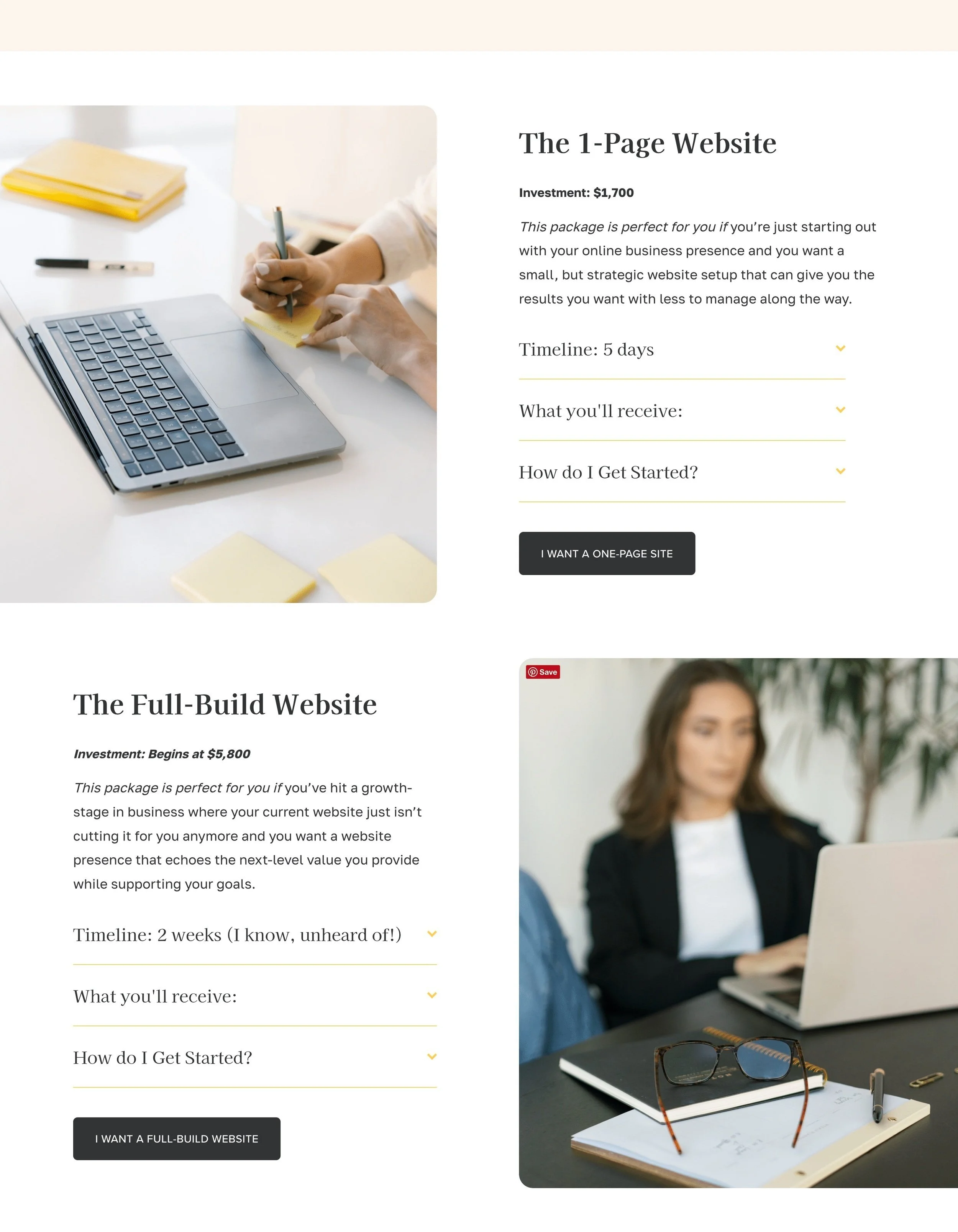The #1 Way to Get Web Design Referrals (+ Upwork Tips You’ll Wish You Tried Sooner)
Prefer to watch?
Here’s the video!
Mentioned in the Video:
*Yup - that’s an affiliate link! My margarita fund thanks you kindly!
Rather read all about it?
If you've ever wondered whether it's truly possible to build a thriving web design business from scratch—meet Shannon from Luminary Studio.
She started her journey with zero professional experience, no formal design background, and just a curiosity about Squarespace.
Fast forward to today?
She runs a six-figure web design business, works with dream clients, and books premium projects—all while living in Honduras and managing multiple businesses.
But here’s the thing: Shannon didn’t follow the typical path. She didn’t dive in full-time right away. She didn’t rely on social media or trendy marketing tactics.
Instead, she took a strategic, sustainable approach, slowly growing her skills, refining her offers, and building a client acquisition system that actually worked for her.
In this interview, Shannon shares:
✔ How she built her business while working part-time for years
✔ Her exact strategy for landing $6K+ clients on Upwork
✔ Why she didn’t offer templates (and what she did instead)
✔ The game-changing moment when she decided to go all-in
And the best part?
You can learn from her journey and apply it to your own business—without years of trial and error.
So grab your coffee (or a piña colada, because Shannon’s probably by the pool right now 😉), and let’s dive into her story.
How It All Started—A Random Website Redesign Offer
Back in 2017, Shannon had zero professional web design experience—but that didn’t stop her from diving in headfirst.
"Honestly, I was just working at a company answering phones. And I’ve never been the type to just follow the rules and do what I’m told. I like to dig in and figure things out for myself. So, when they told me,
‘Hey, feel free to browse through our company drive to get familiar with things,’
I took that literally."
While poking around, she landed on their website.
"I saw it and immediately thought, ‘We should redo this.’ So I casually mentioned it to my boss, like,
‘Hey, have you ever thought about redoing the website?’
And they were like,
‘Yeah, actually, we’ve sent out quotes before, but we never went through with it.’"
And that’s when Shannon took a bold leap.
"I just blurted out, ‘I can do it!’ even though I had never built a website before in my life."
At the time, she had just heard about Squarespace because she was trying to build a website for her nonprofit—but she hadn’t actually started yet.
"I knew of Squarespace, but I didn’t even know how to use it. I just knew it was a website platform. But I figured, how hard can it be?"
And surprisingly… they said yes.
"They gave me free rein. I was still answering phones and handling my usual tasks, but they basically told me, ‘Sure, if you can do it, go ahead and work on it between calls.’ And I was like, ‘Well, you’re paying me anyway, so why not?’"
And just like that, Shannon became a web designer—without even meaning to.
Discovering the Course That Changed Everything
As she started fumbling her way through building that first website, she knew she needed help.
"I went into full research mode. I was Googling, watching tutorials, trying to figure out how the heck to make this work. And that’s when I somehow stumbled onto your content, Paige."
At some point, she must have signed up for something, because next thing she knew, she was watching one of Paige’s webinars.
What really hooked her was that this wasn’t just about learning how to use Squarespace—it was about learning how to turn web design into a business.
"I was like, ‘Ohhh, this is so much more than just a website tutorial. She’s teaching the business side of things. And I want to learn that.’"
So, she signed up for the course.
"I had some travel plans at the time, so I downloaded everything and binged it on a plane—literally watched all the lessons during my flights back and forth."
And once she got back? She was hooked.
Doing Free Projects to Build Confidence
Even after finishing the course, she still wasn’t charging for her work yet.
"At first, I did websites for free. I felt like I had to because I was still figuring things out."
But even though she wasn’t making money yet, she was gaining experience.
"I designed websites for local businesses, a nonprofit gym, and a few friends. And yeah, I wasn’t getting paid, but they were helping me just as much as I was helping them. I was learning. I was figuring things out. And every project made me better."
It wasn’t long before she started realizing—this could be something real.
Turning a Hobby into a Legit Business
For a while, web design was just a side hustle. But then, life took a turn.
"My husband is Honduran, so when I moved to Honduras, I needed something I could do remotely. And I had already started this web design journey, so I thought… this could actually be perfect."
At first, she wasn’t sure if she could make a full-time living from it.
"I kept thinking, ‘Can I actually do this? Is this really a business?’ So for a long time, I treated it as a part-time gig."
But then, everything changed.
"A year ago, I told myself—cut out distractions. Stop treating this like a side thing. Go all in and build this before worrying about anything else. And once I did that… everything started falling into place."
Taking Messy Action (Even as a Perfectionist)
One of Shannon’s biggest lessons? Just start. Even if it’s messy.
"I’m a huge perfectionist. But I had to realize that waiting until things are perfect actually holds you back."
So instead of overthinking, she just took action.
She threw together a one-page website—with stock images, minimal copy, and a simple layout.
She didn’t even have a portfolio at first because she didn’t have time to make graphics.
She listed random ‘coming soon’ services just to fill space.
She used a tiny, barely-visible travel photo of herself because she hated the idea of her face all over her website.
"It wasn’t perfect. Not even close. But it was out there. And that’s what mattered."
Her biggest piece of advice?
"If you wait until everything is perfect, you’ll never start. Just get something out there. It doesn’t have to be flawless—it just has to exist. You can always tweak it later."
How Shannon Finds Clients
Clients Find Me, and I Find Them
These days, Shannon has a steady stream of clients—but that wasn’t always the case.
"It’s a little bit of both. I find people, and they find me. But it wasn’t always this way—it’s been a process of figuring out what actually works over the years."
Starting on Upwork (And Why It Wasn’t Easy at First)
Shannon actually joined Upwork ten years ago—long before freelancing and remote work became what they are today.
"I got on Upwork a decade ago, and honestly? I struggled. I think the world wasn’t quite ready for remote work yet. It wasn’t as easy to find clients—or at least, it wasn’t for me."
She watched other people thrive on the platform, but it took time for her to figure out what worked.
"At first, I wasn’t getting much traction. Maybe other people were killing it on there, but for me, it felt like I was constantly applying and not hearing back."
The Key to Getting Hired on Upwork
Instead of applying to every job she saw, Shannon started narrowing her focus and perfecting her proposals.
✔ She only applied to jobs she actually wanted.
✔ She personalized every single proposal. No copy-paste applications.
✔ She kept tweaking her cover letter over time, making it stronger.
"I would find a job that I really wanted, and instead of sending a generic pitch, I’d tailor my proposal to that specific client. And eventually, it started working."
Covid Changed Everything
When Covid hit, everything went online. Shannon knew it was time to take her business more seriously.
"I’d been doing web design part-time, maybe three-quarters time, but when the world went digital overnight, I thought, this is the moment."
She put even more effort into Upwork and started thinking long-term.
"I didn’t want to spend all my time constantly hunting for clients. That’s a job in itself, and I couldn’t afford to hire someone to do it for me. So I thought… how can I make this easier?"
That’s when she started learning SEO—not just for websites, but for her own Upwork profile.
"Even on freelancer platforms, SEO matters. I realized I needed to make my profile optimized so that clients could find me—not just the other way around."
Why Relying on One Platform is Dangerous
Even though Upwork was working for her, Shannon didn’t want to rely on just one platform.
"It’s like social media. If your entire business is built on one place and something happens—you get locked out, you lose your account—you have nothing."
She realized that freelancer platforms come with risk.
"If I got kicked off Upwork for some misunderstanding, if there was some dispute, what would I do? That was terrifying to think about."
So she started focusing on referrals and word-of-mouth marketing.
"At heart, I’m old school. I love the referral network. But for a while, I wasn’t getting as many as I expected."
The Simple Email Line That Changed Everything
For a long time, Shannon felt like she should be getting more referrals—but they just weren’t coming in.
“If you loved working together, referrals are always appreciated!”
"I kept wondering, why aren’t more past clients sending people my way? My testimonials were glowing. My clients were thrilled. So what was missing?"
Then, she had a realization—she had never actually asked for referrals.
So she changed one tiny thing: she added one simple sentence to the final email she sends after every project.
👉 “If you loved working together, referrals are always appreciated!”
And just like that… everything changed.
"I cannot tell you how many clients immediately emailed me back saying, ‘Oh my gosh, yes! I have this person and that person I need to refer to you.’"
Why This Works
People don’t think about referring unless you remind them. Even happy clients don’t always realize you want referrals unless you say it directly.
It’s simple. There’s no big, awkward ask—just a casual mention.
It takes zero extra effort. You’re already sending a final project email. Just add the line!
"I was overcomplicating everything. I thought I had to do social media, blogging, create all this content. And then I realized… nope, just put the line in the email."
The Game-Changing Shift to a Referral-Based Business
Once Shannon saw how well this worked, she made referrals her main marketing focus.
"Ever since I added that line, I’ve had clients actively respond to that email—not just saying ‘Thanks for the project’ but literally listing out people they want to refer me to."
Now, 2025 is fully booked with referral-based projects.
"Literally my entire year is filled with referrals. And all I did was add one line to my emails. That’s it. Game. Changer."
Want More Clients? Steal This Trick.
Shannon’s strategy is so simple, you can implement it today:
Go into the last email you send clients after a project.
Add this line: “If you loved working together, referrals are always appreciated!”
Watch your inbox fill with new leads.
It’s the easiest marketing strategy ever. No ads, no complex funnels—just a simple reminder.
"Seriously, try it. It takes five seconds. And it works."
From Packages to Profit: How Shannon Built Her Offer Suite & Increased Her Pricing
The Evolution of Shannon’s Offers (And What She Loves Now)
At first, Shannon experimented with different offerings—from VIP days to full-service packages—until she found what truly worked for her.
"I originally had a couple of different packages, but then I got caught up in that ‘shiny object syndrome’—you know, seeing everyone doing VIP Days and ‘Website in a Day’ packages and thinking, ‘Oh, this must be the way to go!’"
But she quickly realized… VIP Days were not for her.
"I cannot do that. My stress levels go through the roof, and knowing I have a hard stop in one day actually hurts my creativity instead of helping it. It just doesn’t work for me."
So instead, she focused on a simple, scalable offer structure that works for both her and her clients.
The Genius Two-Tier Website Package
Shannon’s offer suite is brilliantly designed to build a natural client funnel.
🔹 Offer 1: The One-Page Website (for startups & side hustlers)
Perfect for clients who are just getting started or still side-hustling.
Helps them launch without needing a huge investment.
Simple, streamlined, and exactly what they need to start.
🔹 Offer 2: The Full Website Build (for businesses ready to grow)
A natural next step for clients who already worked with her.
Once they’re established and growing, they come back for a full site.
Automatically creates a built-in client pipeline.
"It’s simple. People start with the one-pager, and when they’re ready to expand, I’m already their go-to designer because they’ve worked with me before. It builds my own funnel naturally!"
And beyond websites, Shannon also gets requests for landing pages and sales pages, which fit seamlessly into her structure.
So many clients reach out just needing a landing page, and because I already offer one-page websites, it makes perfect sense."
Pricing Mistakes & What She Learned
When Shannon first launched her One-Page Website, she priced it too low.
"I think I started at $500 or maybe $800. But then I quickly realized… these clients need way more than just the website itself."
Because new business owners rarely have everything ready (copy, images, branding, etc.), Shannon found herself doing way more than expected.
Biggest Lesson: Price for the Real Scope of Work
"You have to factor in the actual work you’ll end up doing. Because if your clients don’t have copy, images, or a solid offer, guess what? You’re going to be the one helping them with all of it."
So, she more than doubled her pricing.
"I realized I needed to build that extra work into my package from the start. So I priced it accordingly and made everything super clear on the sales call."
Her approach? Make the offer a no-brainer.
"My clients don’t always know what they need, so I answer their questions before they even ask. I don’t make them work for it. Everything they need is already built into the package."
And that approach works. Clients trust her because she removes friction from the process.
How Shannon Raised Her Prices Over Time
At first, Shannon didn’t charge much at all.
"In the very beginning, I did projects for free just to build my portfolio. But if I could go back, I’d do it differently."
Her advice? Always charge something—no matter how small.
"Even if it’s just $250, make sure there’s some level of investment. If a client isn’t paying anything, they won’t take it seriously, and neither will you."
Her Pricing Progression
Started with free projects (wouldn't do this again).
Moved to charging $250 to establish value.
Raised it to $500, then $800 for small sites.
Jumped to $3K for full websites (but often negotiated down).
Eventually scaled beyond $6K+ per project.
"At first, my goal was to hit $3K. But I kept negotiating down to $1500, which didn’t feel good. I was giving so much value and wasn’t being compensated fairly."
Eventually, she set her sights even higher.
"Now, $3K is less than half of what I charge. And looking back, I wish I had stopped underselling myself sooner."
Overcoming the Fear of Charging More
So many designers struggle with the fear of raising prices and losing clients.
Shannon’s mindset? There’s always another client.
"There are millions of people out there. If one person says no, another will say yes. It’s not the end of the world."
In fact, turning down low-budget clients actually opens up space for premium ones.
"If you say yes to the wrong client, you’re saying no to the right one. Because now you’re busy, burned out, and not marketing to the people willing to pay your actual worth."
She saw this firsthand on Upwork.
"People assume Upwork is just low-budget projects, but that’s not true. I get invited to submit proposals all the time, and I always price at my actual rate. And guess what? The right clients say yes."
The Clients Who Pay More Are the Best Clients
Shannon has noticed that higher-paying clients are actually easier to work with.
🔹 They trust you—fewer edits, less micromanaging.
🔹 They value your work—no begging for discounts.
🔹 They respect your process—fewer delays and back-and-forths.
"The clients who immediately say yes and pay in full? Those are the dream clients. Those are the people you want to work with."
So now, she only works with clients who respect her expertise.
"If someone tries to lowball me or ask for a discount, I let them go. Because I know there’s someone else out there who will pay my rate—and actually appreciate my work."
How Square Secrets Business™ Changed Everything
Before Square Secrets Business™, Shannon’s web design business was basically… non-existent.
"Before the course, I didn’t have a business. I was just figuring it out on my own, with no real plan."
The biggest value? She learned from Paige’s mistakes—so she didn’t have to make them herself.
"People say, ‘The best teacher is failure.’ No, sorry. The best teacher is learning from someone else’s failures so you don’t have to repeat them."
Why Investing in Education Was a No-Brainer
At first, paying for the course felt like a stretch.
"I remember watching the webinar and debating it. There was a $100 off discount, but I missed the deadline, and I was so mad at myself. I ended up signing up anyway, but I was kicking myself over that lost discount!"
Now? She’d pay for it again in a heartbeat.
"Knowing what I know now, the price of the course is nothing compared to the value I got. It completely changed my business."
The Business Model That Works—And How You Can Steal It
Shannon’s journey proves that you don’t need a million offers—just the right ones.
Start with a simple, scalable offer (like her one-page site).
Build a natural funnel so clients want to upgrade later.
Raise your prices based on actual work— don’t undersell yourself.
Work only with clients who respect your value.
And most importantly? Believe in your worth.
"Charge what you’re worth, stick to it, and trust that the right clients will come. Because they will."
Mastering Upwork—How Shannon Lands $6K+ Clients Consistently
Shannon has spent years refining her strategy for finding high-paying clients on Upwork—and now, she’s sharing exactly how she does it.
Biggest Misconception: “There Are No High-Paying Clients on Upwork”
Many people assume that Upwork is only for low-budget projects—but Shannon has proven that’s simply not true.
"People think there aren’t high-paying projects on Upwork. But my average project price is between $5,500 and $6,000."
She’s consistently booking high-quality clients—and it all comes down to the right approach.
How Shannon Finds Premium Clients on Upwork
She follows a two-filter system to weed out low-paying projects and find the right opportunities.
Step 1:
Set the Right Filters
Shannon applies two main filters to instantly narrow down quality leads:
✔ Hourly Rate Filter: Minimum $60+
"I don’t usually do hourly work, but if I do, I want high-quality clients. Setting a $60+ hourly minimum weeds out the low-budget ones."
✔ Fixed-Rate Filter: $1K+ and $5K+
"I check both boxes—$1K+ for one-page sites and $5K+ for full websites. That way, I find the right projects for my offer suite."
🚨 She completely ignores projects priced too low.
"If I see someone offering $1K for a full website, I don’t apply. But if they’re at $4K, I pitch them $6K—and it works."
Clients often start lower but are willing to pay more for the right person.
"I’ve had so many people say, ‘You’re higher than the rest, but I love your work and really want to work with you.’"
Step 2:
Writing a Winning Proposal
Many freelancers copy and paste generic proposals—but Shannon personalizes everything to stand out.
Her Proposal Formula:
🔹 Strong First Sentence (With Authority)
"I start with something attention-grabbing, like ‘As a top-rated freelancer on Upwork…’ Anything that makes me stand out instantly."
🔹 Use the Client’s Name (If Available)
"If they’ve put their name anywhere in the job description, I use it. It makes the proposal feel more personal."
🔹 Showcase Relevant Work (Not Your Entire Portfolio)
"I don’t just paste my full portfolio. Instead, I handpick three sites similar to what they’re looking for."
🔹 Give Clear Pricing & Timelines
"I include my exact timeline, what’s included, and when I’m available. It saves time and shows I’m professional."
🔹 Offer a Portfolio Link (For More Examples)
"I say, ‘If you want to see more, here’s my full portfolio.’ It gives them options without overwhelming them."
Why This Works:
✔ Personalized proposals stand out.
✔ Giving clear details upfront eliminates questions.
✔ It shows professionalism and organization.
"I make sure everything is laid out in a way that makes it easy for the client. The clearer you are, the more likely they are to say yes."
Step 3:
Should You Offer Discovery Calls?
At first, Shannon always did discovery calls. Now? She’s more flexible.
"I have an unorthodox lifestyle. Sometimes I can’t guarantee I’ll have a quiet space or strong Wi-Fi. So I play it by ear."
Her Approach Now:
If the client wants a call? She does it.
If they’re happy booking via messages? That works too.
"Some people love calls for that personal touch. Others just want to move fast. I respect their working style."
Step 4:
How to Get Clients to Pay More Than Their Initial Budget
One of Shannon’s biggest wins is getting clients to pay more than they originally intended.
"I’ll see a client with a $4K budget, and I’ll pitch them $6K—and they say yes. Why? Because I make it an easy yes."
What Makes Clients Choose Her (Even at a Higher Price)?
✔ Everything is crystal clear.
"I use the ‘Don’t Make Me Think’ rule—clients don’t have to guess what they’re getting or what happens next."
✔ She removes friction.
"I simplify everything. Clients feel like working with me will be easy, and that’s a huge selling point."
✔ She has strong branding.
"Having high-quality graphics in my portfolio makes a difference. People are drawn to polished visuals."
Pro Tip:
How to Make Your Portfolio Look More Premium
Clients make split-second decisions based on how polished your work looks.
Here’s how Shannon elevates her portfolio:
🔹 Use high-quality mockups.
"One plain screenshot isn’t enough. I use professional-looking mockups to make my work pop."
🔹 Keep mockups straight-on (not angled).
"Angles add unnecessary complexity. I use simple, front-facing computer and phone mockups to showcase my sites."
🔹 Use Canva (If You Don’t Have a Graphic Designer).
"If you can’t hire a designer, Canva has great stock images. Just crop your screenshot and drop it in."
🔹 Systemize it.
"I have a pre-made Canva file with different slides ready. Whenever I finish a project, I just drop in my screenshots and go."
Why Shannon’s Upwork Strategy Works
Shannon has proven that high-paying clients exist on Upwork—if you know how to find them.
Use the right filters to eliminate low-budget projects.
Send personalized proposals that stand out.
Be clear, organized, and professional from the first message.
Price yourself for what you’re worth—and don’t be afraid to pitch higher.
Make your portfolio visually appealing.
"The clients who say, ‘You’re more expensive, but I want to work with you’? Those are the clients you want."
If you follow this process, you’ll start landing premium clients—and you won’t have to fight for low-budget projects ever again.
Running a Web Design Business From Abroad—Shannon’s Lifestyle & Business Balance
Shannon isn’t just running a web design business—she’s balancing multiple businesses, a nonprofit, and a remote lifestyle in Honduras. Here’s how she makes it all work.
Shannon has lived in Honduras for 10 years and has created a life that gives her both freedom and structure.
"There’s no typical day as a web designer here, but I’ve found my rhythm. It’s all about knowing when my energy is best for different types of work."
How She Structures Her Workday:
Mornings = Creative Work
"I do my most creative work—like website design—in the mornings. That’s when my brain is sharpest."
Afternoons = Tedious Tasks
"Afternoons are for more mindless work—like uploading blog posts, mobile optimization, or admin tasks."
Evenings = No Work After 7PM
"I have to cut myself off at night, or I won’t sleep. My brain just keeps going."
Shannon also listens to the weather when deciding how she works.
"If it’s raining, I love working all day because I don’t feel like I’m missing out on anything outside. But if it’s sunny and beautiful, I get a little FOMO. I have businesses in the downtown area, so sometimes I’ll check in on them or move around."
Her approach? Flexibility + Structure = Balance.
Balancing a Web Design Business With Other Businesses
Beyond web design, Shannon runs multiple businesses and a nonprofit.
"People always ask, how do you juggle all of this? And my answer is simple: delegation."
Her Rule: Hire & Delegate Whenever Possible
🔹 Her web design business = solo, but with freelancers.
"I don’t have an in-house team, but I do hire freelancers when I need extra help."
🔹 Other businesses = fully delegated teams.
"I have teams in place to run my other businesses so I can focus on the bigger picture."
Shannon has learned that just because she can do something doesn’t mean she should.
"Yes, I can do graphic design. But does that mean I should spend my time on it? No. If I want to focus on growing my business, I need to let go of things that aren’t my zone of genius."
How She Delegates Social Media
One of her biggest time savers? Outsourcing social media.
"Social media was such a distraction for me. So I hired someone to manage it."
Her process:
🎙 She records a 7–10 minute voice note once a month with all her ideas and sends it to her social media manager.
📌 Her social media manager pulls content ideas from it.
📅 They strategize and schedule posts without her having to overthink it.
"Instead of me spending hours figuring out what to post, I just talk through my ideas, and they handle the rest."
Why Delegation Matters (And How to Do It Right)
Shannon’s approach to delegation is intentional. She only hires for things she’s actively resisting.
*"When I was redesigning my own website, I kept making excuses:
‘I don’t have the right copy.’
‘I don’t have the perfect images.’
‘I should rebrand first.’
So I asked myself, what are the things I’m avoiding? And then I hired people to do those things.*
The 3 Things She Hired Out For Her Own Website:
Copywriting—because she kept overanalyzing her words.
Branding—because she wanted a professional refresh
Brand Photography—because stock images weren’t cutting it.
"I realized… if I expect my clients to trust me as the expert, I need to trust other experts too."
And once those pieces were done?
"I had no excuse not to finish my website. If I didn’t do it, that was on me."
Pro Tip: Hire Experts, Not Just the Cheapest Option
Shannon is willing to pay a premium for peace of mind.
"I don’t hire based on price—I hire based on expertise. Because when I trust the people I hire, I don’t have to micromanage."
Her advice?
✔ Start small. If you’re new to delegating, hire a beginner VA or freelancer.
✔ As you grow, invest in top talent. More experience = less hand-holding.
✔ Think about ROI. A high-quality hire saves you time, stress, and money in the long run.
"Your peace of mind is worth paying for."
Finding Balance in Business & Life
Even with multiple businesses, Shannon makes time for herself.
Her Strategies for Managing Stress:
📵 She puts her phone on Do Not Disturb.
"I was constantly distracted by WhatsApp messages, so I set work hours where I don’t check my phone."
🏋️♀️ She has an intense workout routine.
"I do CrossFit, jujitsu, and weightlifting. It’s my therapy. The workouts are so intense, I have to turn my brain off—which is exactly what I need."
🚶♀️ She avoids “low-intensity” activities that don’t clear her mind.
"Taking a walk? No. My brain keeps thinking about work. I need something hard that forces me to be fully in the moment."
Her approach? Structure your life to give yourself mental breaks.
"If you’re always on, you’re going to burn out. You have to be intentional about when to shut off."
Why Shannon Didn’t Add Templates to Her Business
For a while, Shannon considered selling website templates. But after thinking through the reality of it, she decided not to.
Two Big Reasons She Avoided the Template Model:
1️⃣ Customer Service Headaches
"I didn’t want to spend my time answering ‘Where do I find this link?’ emails or constantly updating tutorial videos."
2️⃣ Marketing Would Become Her Full-Time Job
"Selling templates is amazing if you want to spend all your time on marketing. But that wasn’t what I wanted."
Shannon realized that if she wasn’t excited about it, it wasn’t worth pursuing.
"There’s a difference between what’s a good business model and what’s the right business model for you."
Instead, she focused on what truly excited her: business consulting.
"I already had web design clients coming to me saying, ‘I need your strategic brain on my business.’ And that was something I loved doing."
The Lesson? Don’t Follow Trends—Follow What Works for You.
"Passive income is great, but only if you actually enjoy the thing you’re selling. Otherwise, it just becomes another job."
Final Thoughts: Running a Business Your Way
Shannon has built a multi-business empire by staying true to what works for her.
She created a schedule that fits her energy levels.
She learned how to delegate (without micromanaging).
She chose not to pursue templates—because it didn’t excite her.
She focused on what she actually enjoys—like consulting.
Her biggest takeaway?
"You don’t have to do business like everyone else. You just have to find what works for you."
What Changed When She Went All In in 2023?
For five years, Shannon balanced web design with other businesses. But in 2023, she knew it was time to fully commit.
"I was doing well—even part-time, I was making a great income for Honduras. But I knew my business had way more potential."
So she made the decision:
🚀 2023 would be the year she went all in.
"I didn’t want to look back and feel like I left potential on the table. So I went all in—and that’s when my business skyrocketed."
The Mindset Shift: Treating Web Design as a Real Business
🔹 She stopped balancing too many things at once.
"You cannot grow something if your energy is spread across too many projects. I needed to focus."
🔹 She prioritized Luminary Studio above all else.
"I didn’t ignore my other businesses—I just shifted my energy to put web design first."
🔹 She removed every excuse.
"I kept saying, Oh, I need better copy. I need new branding. I need new images.
So I hired the best people I could find to get it all done."
The biggest turning point? Taking decisive action.
"I set a deadline for myself—April 2023. I became my own client and launched my site in one week."
And from that moment on, her business exploded.
The Only Change She Made—And Why It Led to More Clients
Interestingly, Shannon didn’t change her marketing strategy.
She didn’t start running ads.
She didn’t build a massive content strategy.
She didn’t suddenly start showing up on social media every day.
All she did? She made her business look legit online.
"I didn’t have to do anything different in marketing. I just had to look more legit on the internet. And then? Clients started booking immediately."
What She Invested In (And Why It Was Worth It)
To make her website look next-level professional, she invested in:
Branding → $2,500–$3,000
Photography → $3,000 (plus a trip to Austin for the shoot)
Copywriting → $6,000
At first, she hesitated over the copywriting price.
"It was my biggest investment, and I wasn’t sure. But then I asked myself:
How much money am I losing by NOT doing this?"
That sealed the deal.
"Once I made that investment, everything else fell into place. And now? $6K is one project for me. It was beyond worth it."
Investing in Yourself Is Always Worth It
When it comes to investing in your business, Shannon’s advice is simple:
🔹 Ask yourself what happens if you don’t invest.
"If not making the investment means losing more money, then just do it."
🔹 Paying more often = better results.
"I chose the most expensive copywriter because I wanted the best. And that decision paid off."
🔹 Your return on investment will be way bigger.
"The money I spent on branding, photography, and copy? I made it back instantly after launching my new site."
She applies the same logic to hiring a web designer.
"Why do clients hire us? Because they want to look more legit online. That’s exactly what I needed too!"
And the result?
🚀 A completely booked-out business, with premium pricing and dream clients.
Final Takeaway: Just Go for It
If Shannon could give one last piece of advice to anyone considering the course?
"You don’t have to figure this out on your own. You can try… but it’s going to take way longer and be way harder."
Instead?
"Learn from someone who’s already done it. That’s what Paige’s course gives you—the exact path to follow, so you don’t waste years figuring it out yourself."
If you’re ready to take your business seriously—just do it. You won’t regret it.
Shannon’s story is proof that building the business of your dreams is absolutely possible—and it all starts with finding the right clients.
But here’s the thing: The best client-finding strategy isn’t about chasing the latest trends or jumping on every new, shiny tactic. It’s about discovering a method that feels natural, aligns with your strengths, and helps you attract the clients you actually want to work with.
If you’re ready to figure out your ideal way to land dream clients, take my quiz: Which Client-Finding Method Matches Your Personality?
In just a few minutes, you’ll uncover the perfect strategy for growing your web design business—without the overwhelm, guesswork, or endless trial and error.
You’ll Also Love...
The Secret to No-Code Web Design: How Squarekicker is Changing Squarespace Forever
What if Clients Can’t Afford My Rates? - A Web Designer’s Guide to Creative Niches
Serving a Local Niche While Traveling: A Web Designer’s Guide to Digital Nomading
How this Stay-at-Home Mom Earns $6K/Month in Just 10 Hours a Week













